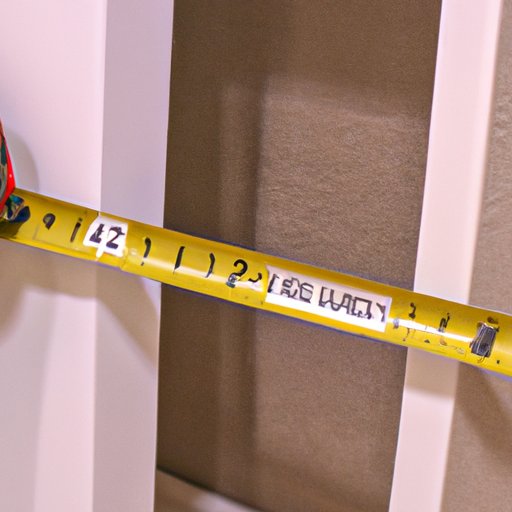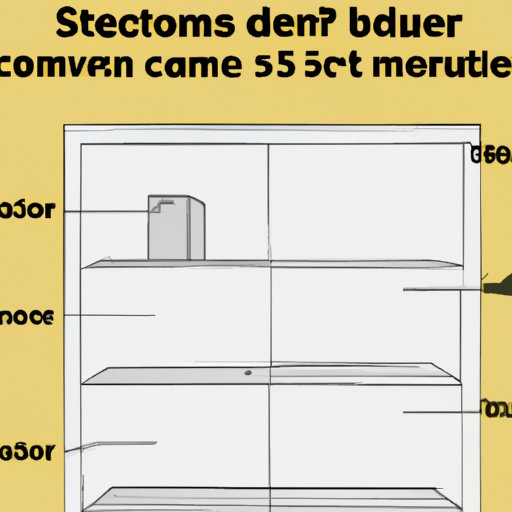Introduction
The depth of a closet is an important factor in determining how much storage space is available, as well as the overall look and feel of the space. But what exactly is closet depth, and how deep should a closet be? In this article, we’ll explore these questions and provide measurement tips, considerations to keep in mind when planning a closet depth, and advice on how to optimize your closet space.
Definition of Closet Depth
Closet depth is the distance from the front wall of the closet to the back wall. It’s typically measured in inches or centimeters and can vary depending on the size of the closet and the type of items you plan to store in it. The standard depth for most reach-in closets is 24 inches, while walk-in closets can range from 36 to 48 inches.

Overview of Why It Matters
The depth of a closet is important for many reasons. For one, deeper closets allow you to store more items, such as long coats, bulky sweaters, and extra bedding. This can help maximize the available storage space and make it easier to organize your belongings. Additionally, deeper closets create a feeling of spaciousness and can make a room look bigger. As interior designer Linda Woodrum explains, “Increasing the depth of the closet by even a few inches can make a huge difference in terms of the visual impact.”

Measurement Tips for Installing a Closet
Measuring the closet depth is an important step in the installation process. Before you begin, it’s important to measure the length, width, and height of the closet space. You’ll also need to select the right hanging rods and shelves for your space, as well as determine the optimal depth for your closet. Here are some tips to keep in mind:
Measuring the Length, Width and Height
To accurately measure the length, width, and height of the closet space, use a measuring tape and mark each measurement on the wall with a pencil. Make sure to measure from the floor to the ceiling and from one side of the closet to the other. This will give you a better understanding of the dimensions of the closet and help you determine the right depth for your space.
Selecting the Right Hanging Rods and Shelves
Once you have the measurements, you’ll need to select the right hanging rods and shelves for your closet. Most closet systems come with adjustable rods that can be customized to fit the length, width, and height of the space. When selecting shelves, make sure to measure the depth of the shelf and the distance between the shelf and the back wall. This will help ensure that your shelves fit properly and don’t protrude too far into the closet space.
Determining the Optimal Depth of Your Closet
The optimal depth of your closet depends on the types of clothes and accessories you have, the amount of storage space needed, the size of the room, and the location of doors and windows. Generally speaking, standard reach-in closets should be 24 inches deep, while walk-in closets should be between 36 and 48 inches deep. However, if you have a large collection of clothing and accessories, you may want to opt for a deeper closet to maximize storage space.

What to Consider When Planning a Closet Depth
When planning a closet depth, there are several factors to consider. These include:
Types of Clothes and Accessories You Have
The types of clothes and accessories you have will influence the depth of your closet. If you have a lot of long coats and bulky sweaters, for example, you’ll need a deeper closet to accommodate them. On the other hand, if you only have a few items, a shallower closet may be sufficient.
Amount of Storage Space Needed
The amount of storage space you need will also affect the depth of your closet. If you have a lot of items to store, you’ll need a deeper closet to accommodate them all. However, if you have a small collection, a shallow closet may be enough.
Size of the Room
The size of the room will also play a role in determining the depth of your closet. If you have a large room, you can opt for a deeper closet to maximize storage space. On the other hand, if you have a small room, a shallower closet may be a better option.
Location of Doors and Windows
Finally, you’ll need to consider the location of doors and windows when determining the depth of your closet. If your closet is located near a door or window, you may need to adjust the depth to avoid blocking the opening.
How to Achieve Maximum Storage with Minimum Space
Maximizing storage space in a small closet can be a challenge, but there are a few strategies you can use to make the most of the space you have. Here are some tips:
Utilizing Vertical Space
Making use of vertical space is key when optimizing a small closet. Installing shelves and hanging rods higher up can help you maximize storage without taking up valuable floor space. Consider using over-the-door organizers, wall-mounted shelves, and adjustable hanging rods to make the most of the space you have.
Adding Extra Shelving
If you need additional storage space, consider adding extra shelves. This can be particularly helpful in small closets, as it allows you to store items off the floor and free up valuable space. You can also add custom drawers and cabinets for added storage.
Incorporating Customized Features
Finally, you may want to consider incorporating customized features into your closet. This can include built-in shoe racks, tie and belt holders, jewelry organizers, and more. Adding these features can help you make the most of the space you have and create a closet that works for you.
Maximizing Your Closet Space: A Guide to Proper Closet Depths
Now that we’ve discussed how to maximize storage space in a small closet, let’s take a look at the proper depths for different types of closets. Here’s what you need to know:
Standard Depths for Reach-In Closets
Most reach-in closets should be 24 inches deep. This is deep enough to accommodate most items, including long coats and bulky sweaters. However, if you have a large collection of clothing and accessories, you may want to opt for a deeper closet.
Standard Depths for Walk-In Closets
Walk-in closets should be between 36 and 48 inches deep. This depth provides plenty of room for hanging clothes, storing shoes, and organizing accessories. However, if you have a smaller collection of items, you may be able to get away with a shallower closet.
Adjusting Depths for Special Needs
If you have special needs, such as a wheelchair user or someone with limited mobility, you may need to adjust the depth of your closet to accommodate them. This may involve installing lower hanging rods and shelves, as well as making sure there is plenty of room for maneuvering.
What You Need to Know About Closet Depths
When it comes to closet depths, there are a few basic rules to keep in mind. Here’s what you need to know:
Basic Rules for Designing Closet Depths
The basic rule of thumb is that reach-in closets should be 24 inches deep and walk-in closets should be between 36 and 48 inches deep. However, the depth of your closet may need to be adjusted based on the types of clothes and accessories you have, the amount of storage space needed, the size of the room, and the location of doors and windows.
Benefits of Having Deeper Closets
Deeper closets offer several benefits, including increased storage space and a feeling of spaciousness. They also make it easier to organize your belongings, as you can store items off the floor and out of sight. Additionally, deeper closets can make a room look bigger, which is always a plus.
Disadvantages of Having Deeper Closets
While there are many benefits to having deeper closets, there are also some drawbacks. For one, deeper closets can be more expensive to install. Additionally, they can make a room feel cramped if not designed properly. Finally, they can block natural light and make a room feel darker.

Optimizing Your Closet Space: The Right Closet Depth for Your Home
Choosing the right closet depth for your home can be a challenge, but it doesn’t have to be. Here are some factors to consider before selecting a depth:
Factors to Consider Before Choosing a Depth
When choosing a closet depth, consider the types of clothes and accessories you have, the amount of storage space needed, the size of the room, and the location of doors and windows. You’ll also want to think about how you plan to use the space, as well as any special needs you may have.
Installation Tips for Installing Deeper Closets
If you decide to go with a deeper closet, there are a few installation tips to keep in mind. First, make sure to measure the length, width, and height of the closet space. Next, select the right hanging rods and shelves for your space. Finally, be sure to account for any doors and windows in the vicinity.
Final Thoughts on Closet Depths
Choosing the right closet depth for your home can be tricky, but it doesn’t have to be. With the right measurement tips and planning, you can find the perfect depth for your space and maximize storage without sacrificing style. So don’t be afraid to experiment and find the right depth for your needs!
Conclusion
The depth of a closet is an important factor in determining how much storage space is available, as well as the overall look and feel of the space. While standard depths for reach-in and walk-in closets are 24 and 36-48 inches, respectively, the optimal depth for your closet will depend on the types of clothes and accessories you have, the amount of storage space needed, the size of the room, and the location of doors and windows. To maximize storage space in a small closet, consider utilizing vertical space, adding extra shelving, and incorporating customized features. With the right measurement tips and planning, you can find the perfect depth for your space and create a closet that works for you.
(Note: Is this article not meeting your expectations? Do you have knowledge or insights to share? Unlock new opportunities and expand your reach by joining our authors team. Click Registration to join us and share your expertise with our readers.)
